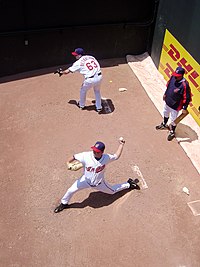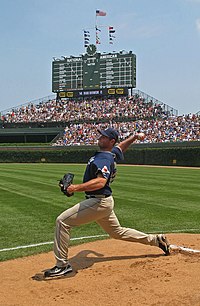Bullpen


In baseball, the bullpen (or simply the pen) is the area where relief pitchers warm-up before entering a game. Depending on the ballpark, it may be situated in foul territory along the baselines or just beyond the outfield fence. Also, a team's roster of relief pitchers is metonymically referred to as "the bullpen". These relievers usually wait in the bullpen when they have yet to play in a game, rather than in the dugout with the rest of the team. The starting pitcher also makes his final pregame warmups in the bullpen. Managers can call coaches in the bullpen on an in-house telephone from the dugout to tell a certain pitcher to begin his warmup tosses.
Origin of the term
The origin of the term bullpen, as used in baseball, is debated, with no one theory holding unanimous, or even substantial, sway. The term first appeared in wide use shortly after the turn of the 20th century[1] and has been used since in roughly its present meaning. According to the Oxford English Dictionary the earliest recorded use of "bullpen" in baseball is in a 1924 Chicago Tribune article from October 5. The earliest known usage of the term "bull pen" relating to an area of a baseball field is in a New York Times article from June 24, 1883[2]. The earliest known relief pitching related usage of "bullpen" in the New York Times is in an article dated September 18, 1912[3].
Some theories about the possible origin of the term bullpen include:
- During the Civil War in the United States, the notorious Andersonville prison camp featured a bullpen.
Though conditions were initially a vast improvement over Richmond detention centers, problems grew in proportion to the number of inmates. By late summer 1864, the prison population made Andersonville one of the largest cities in the Confederacy. At its peak in August, the "bullpen," built to lodge up to 10,000 enlisted men, held 33,000 grimy, gaunt prisoners, each one crammed into a living area the size of a coffin. Their only protections from the sun were "shebangs," improvised shelters constructed from blankets, rags, and pine boughs, or dug into the hard, red Georgia clay.[4]
This wartime usage in the United States has occurred as recently as World War II. Tokio Yamane described conditions in Japanese relocation camps, referring to a "bull pen" within a stockade at Tule Lake, California.
Prisoners in the stockade lived in wooden buildings which, although flimsy, still offered some protection from the severe winters of Tule Lake. However, prisoners in the "bull pen" were housed outdoors in tents without heat and with no protection against the bitter cold. The bunks were placed directly on the cold ground, and the prisoners had only one or two blankets and no extra clothing to ward off the winter chill. And, for the first time in our lives, those of us confined to the "bull pen" experienced a life and death struggle for survival, the unbearable pain from our unattended and infected wounds, and the penetrating December cold of Tule Lake, a God Forsaken concentration camp lying near the Oregon border, and I shall never forget that horrible experience.[5]
- Temporary holding facilities for rebellious hardrock miners trying to organize into unions were referred to as bullpens. These were sometimes literally pens normally used for cattle which were pressed into service by stringing barbed wire, establishing a guarded perimeter, and keeping large numbers of men confined in the enclosed space. These "bullpens" have been considered early versions of concentration camps,[6] and were used by the national guard during the Colorado Labor Wars of 1903-04, and in Idaho in 1892 and 1899 during union miners' uprisings near Coeur d'Alene. In his autobiography Bill Haywood described Idaho miners held for
Penned up in bullpens as a response to violence, many hundreds of union men had been imprisoned without trial. Peter Carlson wrote in his book Roughneck...months of imprisonment in the bull-pen, a structure unfit to house cattle, enclosed in a high barbed-wire fence.[7]
Haywood traveled to the town of Mullan, where he met a man who had escaped from the bullpen. The makeshift prison was an old grain warehouse that reeked of excrement and crawled with vermin. Overcrowding was so severe that some two hundred prisoners had been removed from the warehouse and quartered in railroad boxcars.[8]
- In the 1800s, jails and holding cells were nicknamed "bullpens", in respect of many police officers' bullish features – strength and a short temper.
- The bullpen symbolically represents the fenced in area of a "bull's pen", where bulls wait before being sent off to the slaughter. The relief pitchers are the bulls and the bullpen represents their pen.
- The name may be a reference to rodeo bulls being held in a pen before being released into the main arena.
- Latecomers to ball games in the late 19th century were cordoned off into standing-room areas in foul territory. Because the fans were herded like cattle, this area became known as the "bullpen", a designation which was later transferred over to the relief pitchers who warmed up there.
- At the turn of the century, outfield fences were often adorned with advertisements for the Bull Durham brand of tobacco. Since relievers warmed up in a nearby pen, the term "bullpen" came about.
- Manager Casey Stengel suggested the term might have been derived from managers getting tired of their relief pitchers "shooting the bull" in the dugout and were therefore sent elsewhere, where they wouldn't be a bother to the rest of the team – the bullpen. How serious he was when he made this claim is not clear.
- Jon Miller, a baseball play-by-play announcer with ESPN, said the term is derived from the late 19th century. The New York Giants first played at the Polo Grounds, which opened around 1880. The relief pitchers warmed up beyond the left-field fence, and in the same area was a stockyard or pen that had bulls in it.
Another theory is that for one team, relief pitchers warmed up near a sign for Bull Durham tobacco and thus became known as the bullpen..[9]
Other meanings
Other current meanings of the term include:
- Reference to a large open work area consisting of desks with no separating walls and private offices. Bullpens were common across many business fields in the first half of the 20th century and are often used by software development teams.[10] Michael Bloomberg used this set-up and term at his media company Bloomberg L.P., and for his staff while Mayor of New York City.[11]
- Within USAID, the Office of Transition Initiatives' bullpen represents a surge capacity of experienced professionals that can be called upon to assist in all aspect of office operations and programming.
Notes
- ^ "Etymologies & Word Origins: Letter B". Wordorigins. Archived from the original on 2006-04-28.
- ^ "THE BASE-BALL SEASON" (PDF). - (New York Times reporting on the Providence/New York game of June 23, 1883) "Denny drove the ball into the bull pen in the sixth inning, and would have secured a home run without the ball going outside the fence had he not stepped directly over instead of upon the bag at third base, the umpire giving him out." - retrieved March 10, 2010 - The term here refers to an area of the field that was in-play. Unstated are the specific purpose of the bullpen and whether the area was in fair or foul territory.
- ^ "CUBS BAT MARQUARD OUT OF BOX AND WIN" (PDF). - (New York Times reporting on the Cubs/Giants game of September 17, 1912) "Chicago began to get worried, and Richie, Ruelbach, and Lavender were rushed to the bullpen to get warmed up and be ready to relieve the weakening Cheney at a minute's notice." - retrieved October 20, 2009
- ^ Kleiner, Carolyn. "The Demon of Andersonville" Retrieved March 19, 2007.
- ^ Commission on Wartime Relocation and Internment of Civilians. Personal Justice Denied "Chapter 9: Protest and Disaffection". Washington, D.C., December 1982. Retrieved March 19, 2007.
- ^ Jim Kershner, Carl Maxey: a fighting life, V Ethel Willis White Books, 2008, page 25.
- ^ Haywood, William D. The Autobiography of Big Bill Haywood, 1929, page 81.
- ^ Carlson, Peter. Roughneck, The Life and Times of Big Bill Haywood, 1983, page 54
- ^ Heckle Depot. " Retrieved July 2, 2010.
- ^ Dey & Associates Office Planning Manual
- ^ Nagourney, Adam. "Bloomberg Vows to Work at Center of Things", New York Times
